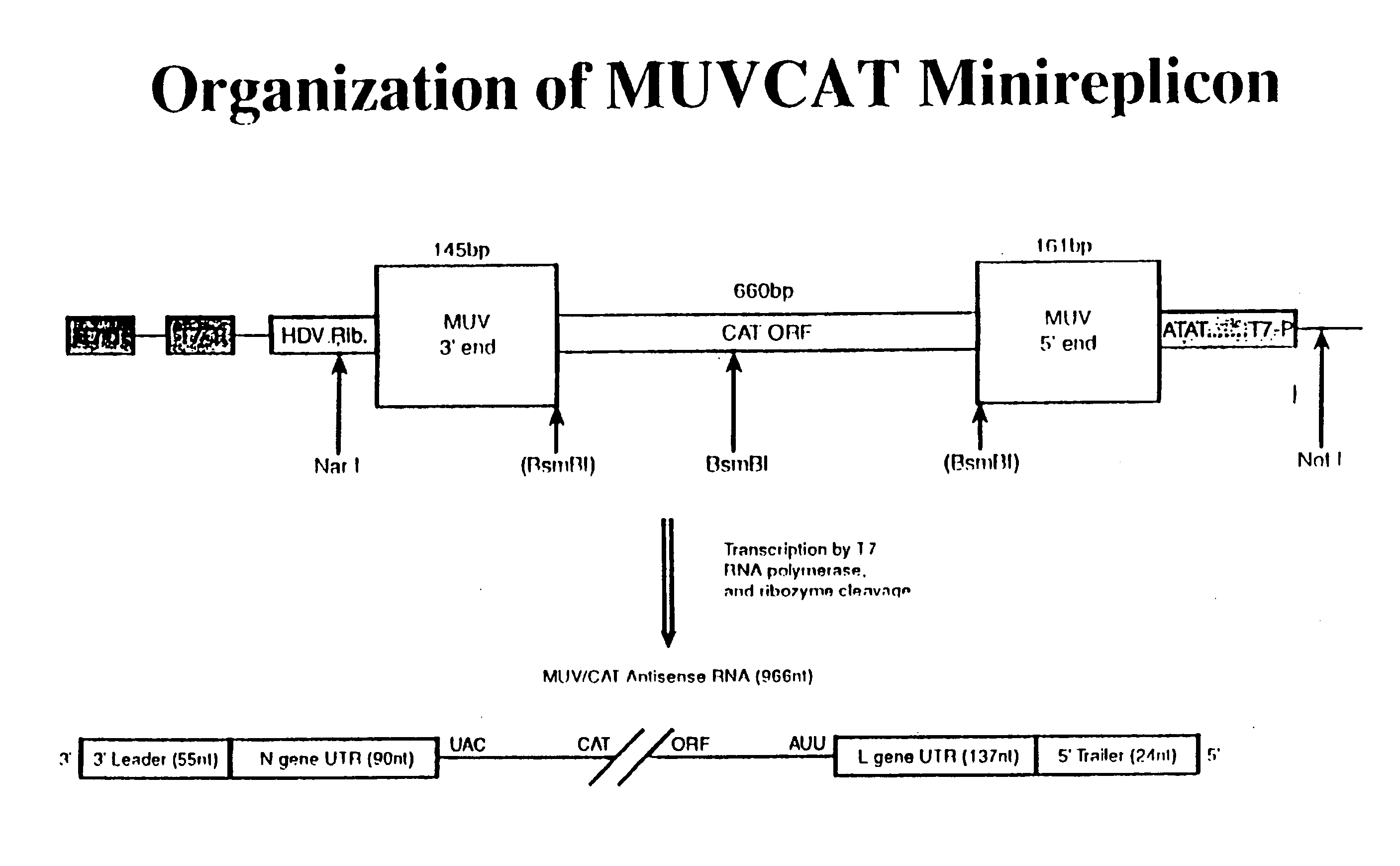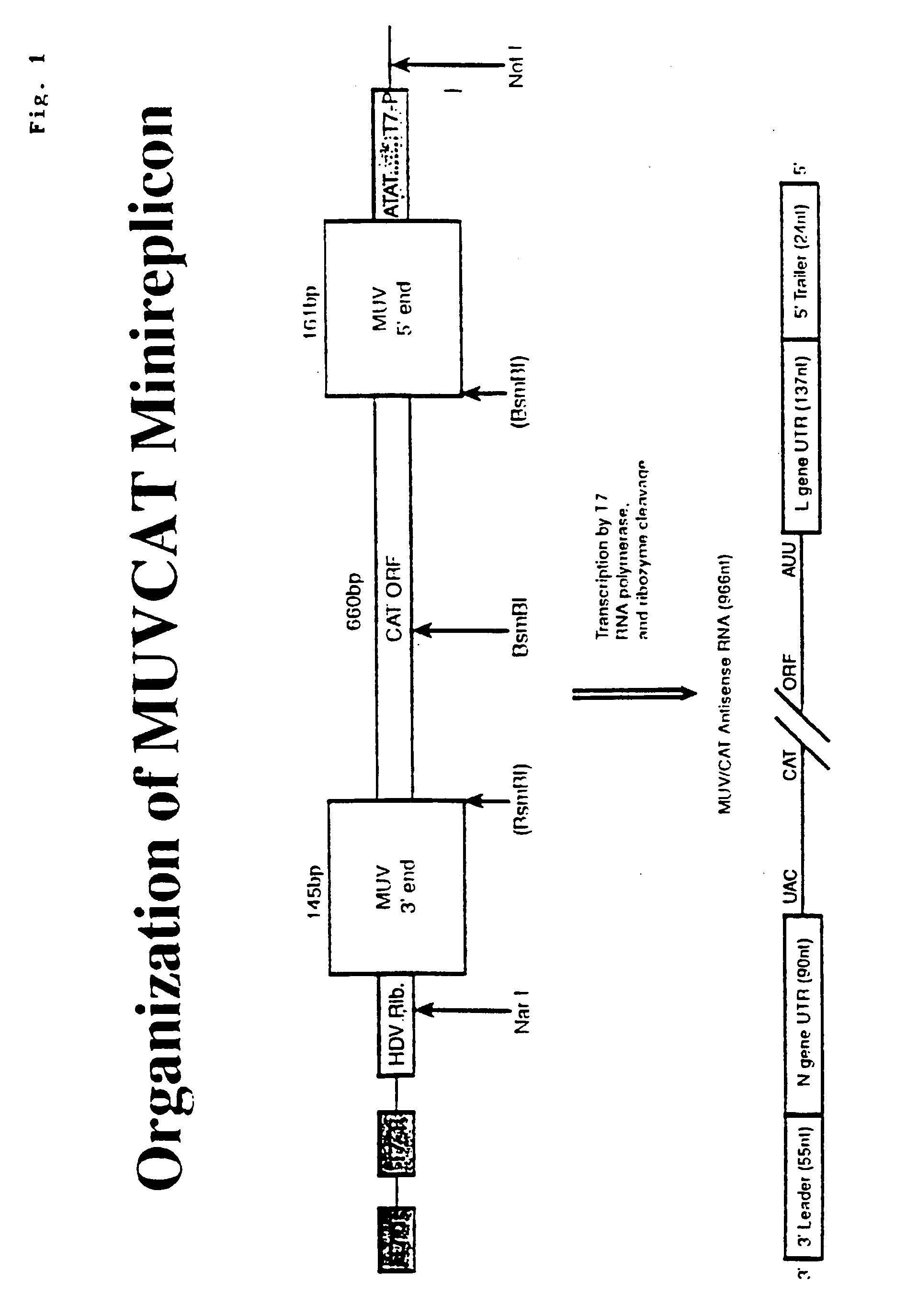Rescue of mumps virus from CDNA
a technology of mumps virus and cdna, which is applied in the field of recombinantly producing mumps virus, can solve the problems of difficult molecular genetic analysis of such nonsegmented rna viruses, difficulty in genetic manipulation of muv and other negative stranded rna viruses, and difficulty in devising a rescue method for mumps virus
- Summary
- Abstract
- Description
- Claims
- Application Information
AI Technical Summary
Benefits of technology
Problems solved by technology
Method used
Image
Examples
example 1
Materials and Methods
[0097] Cells and viruses. Primary chick embryo fibroblast (CEF) cells were obtained from SPAFAS Inc., Preston, CT), and cultured in Eagle's Basal Medium (BME) supplemented with 5% fetal calf serum. Hep 2 cells, 293 cells, A549, and Vero cells were obtained from the American Type Culture Collection (ATCC) and grown in Dulbecco's Modified Eagle Medium (DMEM) supplemented with 10% fetal calf serum. The Jeryl Lynn strain of mumps virus was cultured directly on CEF cells from a vial of Mumpsvax®, Lot Numbers 0089E, 0656J, and 1159H (Merck and Co., Inc., West Point, Pa.). Recombinant vaccinia virus Ankara (MVA-T7), expressing bacteriophage T7 RNA polymerase was obtained from Dr. B. Moss [(National Institutes of Health, Bethesda, Md.), see Wyatt et al., 1995].
[0098] 1.A. Generation of Mumps Virus Jeryl Lynn Consensus Sequence.
[0099] Growth of mumps virus Jeryl Lynn strain stock. Mumps virus Jeryl Lynn strain was cultured directly from vials of Mumpsvax (lot # 1159H,...
example 2
[0117] Rescue of reporter gene activity from transfected cells. In order to help define a system which would permit the rescue of infectious mumps virus from cDNA, a mumps virus minireplicon containing the CAT reporter gene was assembled. The construct was designed to allow synthesis of a RNA minigenome of negative polarity under control of the T7RNA polymerase promoter. The three terminal G residues of the T7 promoter were omitted during construction of the minireplicon in order to provide a transcriptional start site which began with the precise 5′ nucleotide of the MUV genome. Inclusion of the HDV ribozyme in the minireplicon construct permitted cleavage of the T7RNA polymerase transcript to produce the authentic MUV specific 3′ end. The total number of nucleotides (966) in the MUVCAT minireplicon RNA was divisible by six, in agreement with the Rule of Six (Calain and Roux, 1993), which states that unless the genome length is a multiple of six, efficient replication will not occu...
example 3
[0120] Recovery of full length mumps virus from transfected cells. The full length MUV cDNA was assembled in such a way as to permit the synthesis of a precise 15,384nt positive sense RNA copy of the virus genome under control of the T7 RNA polymerase promoter. As with the MUVCAT minireplicon, the T7 RNA polymerase promoter sequence was modified to omit the three terminal G residues, providing a transcriptional start site beginning at the exact MUV terminal nucleotide. The HDV ribozyme was employed to generate the exact MUV 3′ terminal nucleotide of the positive sense genome transcripts.
[0121] To recover MUV from cDNA, A549 cells were infected with MVA-T7 which expresses T7 RNA polymerase, and then transfected with pMUVFL, and plasmids expressing the MUV NP, P and L proteins. Results for rescue of reporter gene activity from the MUVCAT minireplicon along with results from similar work on the related rubulavirus SV5 (He et al, 1997; Murphy and Parks, 1997) indicated that the MUV NP,...
PUM
| Property | Measurement | Unit |
|---|---|---|
| temperature | aaaaa | aaaaa |
| temperature | aaaaa | aaaaa |
| temperatures | aaaaa | aaaaa |
Abstract
Description
Claims
Application Information
 Login to View More
Login to View More - R&D
- Intellectual Property
- Life Sciences
- Materials
- Tech Scout
- Unparalleled Data Quality
- Higher Quality Content
- 60% Fewer Hallucinations
Browse by: Latest US Patents, China's latest patents, Technical Efficacy Thesaurus, Application Domain, Technology Topic, Popular Technical Reports.
© 2025 PatSnap. All rights reserved.Legal|Privacy policy|Modern Slavery Act Transparency Statement|Sitemap|About US| Contact US: help@patsnap.com



